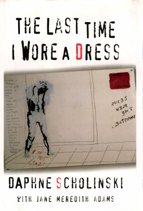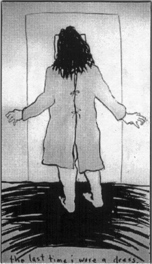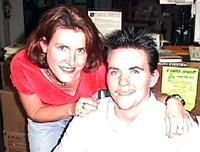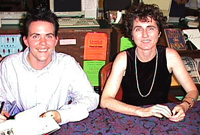
The Last Time I Wore a Dress
Daphne Scholinski with Jane Meredith Adams Riverhead Books/Penguin Putnam, New York, NY 1997 ISBN 1-57322-077-9 Hardcover $23.95
Reviewed by Jamie Faye Fenton

The Last Time I Wore a Dress
Daphne Scholinski with Jane Meredith Adams Riverhead Books/Penguin Putnam, New York, NY 1997 ISBN 1-57322-077-9 Hardcover $23.95 Reviewed by Jamie Faye Fenton |
The ETVC hot line rang. The French boy’s fear was the strongest I had ever sensed. He was certain that someone would trace the call, arrest him, commit him to a mental hospital and ruin his life. All the standard reassurances fail. I barely extract a promise from him to call back sometime, when he feels safe.
I often think of him - he never called again. Surely we live in enlightened times and things like this don’t happen! Nobody is really going to lock you up, feed you drugs, and bombard you with invasive questions and humiliating therapies just for being a tomboy or a sissy?
Actually they do. I saw it happen at close range in my own family - but I was not awake at the time. The full story is in a book entitled The Last Time I Wore A Dress, by Daphne Scholinksi with Jane Meredith Adams.
Daphne is now stealing, making threats, drinking, and taking drugs. On visits to her mother, now living with a mercurial Arab who eventually hijacks a plane, she is sexually exploited by a neighbor who fancies himself a mob hit-man. Daphne is initiated into a local gang, skips school, and continues finding trouble.
 Fed up with the escalating misbehavior, David threads through the social services bureaucracy and sends
Daphne to a locked ward at the Michael Reese Mental Hospital in Chicago. Here we meet a group of characters right
out of Cuckoo’s Nest: Jesus and Jimmi Hendrix resurrected, anorexics, depressives, compulsive
masturbaters, chronic psychotics sitting in their feces all day, head pounders, screamers, and a deaf-mute
cross-dresser named Sandra.
Fed up with the escalating misbehavior, David threads through the social services bureaucracy and sends
Daphne to a locked ward at the Michael Reese Mental Hospital in Chicago. Here we meet a group of characters right
out of Cuckoo’s Nest: Jesus and Jimmi Hendrix resurrected, anorexics, depressives, compulsive
masturbaters, chronic psychotics sitting in their feces all day, head pounders, screamers, and a deaf-mute
cross-dresser named Sandra.
Every movement and remark is analyzed and recorded by staff. It becomes a game, patients try and set each other off and compete to get unusual diagnosis added to their charts. Daphne’s initial labels are: Conduct Disorder with Borderline Personality, Gender Identity Disorder (GID), and Mixed Substance Abuse. Playing games, Daphne has them tack on Anorexia. Disconnected from her mother and father and feeling abandoned, Daphne latches onto sympathetic nurse Kay, longing to be adopted by her.
Daphne has a knack for creative rebellion: trapping the nurses in their station plastered with "Fuck You" signs facing inward; later covering herself with oil so the men in the white coats could not grab onto her; another time giving her friend water so she could avoid shock therapy. Daphne tries out sex with James but is caught.
Rebuffed by nurse Kay, Daphne sinks into depression and drinks facial astringent and lighter fluid. She wakes up in the isolation unit tied to her bed. Some jerk comes in and feels her up. That doesn’t make her into a woman either.
Soon the hospital announces that she must be transferred. Its been 6 months and the official explanation is that her parents are not participating in her treatment. The cynical explanation: the insurance company didn’t like the paperwork it was seeing and was threatening to close the tap.
The 12 step religion washes right over. Daphne does not fit in with the other addicts and alcoholics. She describes her alienation to her diary and adds a brief footnote: i like girls.
A big mistake. It turns out that the staff is reading everything. Found out: The Gender Identity Disorder diagnosis moves to the top of the list. Daphne is transferred to the "Town House" unit and its "point system" for rewarding good behavior. There are tiers of awards leading to the ultimate prize, a brief unescorted walk outside. Wearing makeup, feminine dress, and female behaviors all counted. Daphne dives in and starts accumulating. It was all a fake, endurable only by anticipation of transfer to a long term facility in Minnesota.
Daphne grows attached to another female resident. The staff tries to suppress this, but because no sexual behavior takes place, they relent, pleased with having a new lever at hand. While the glimmerings of the lesbian orientation are there, Daphne feels compelled to push them to the back of the closet.
As her 18th birthday approaches, Daphne is permitted to live off-campus. The "gold mine" insurance policy peters out that day. Plans for her further education are drawn up. For some ludicrous reason, they suggest a career in law enforcement.
 During Daphne’s time at the Wilson Center, I began living with her mother
and sister Jean. Deb retrieves Daphne, who is stable but not well. She moves in and enrolls in a local community college.
Several months later, Deb and
I break up and she and Daphne move out. Eventually Daphne begins her art education and comes out as a
lesbian.
During Daphne’s time at the Wilson Center, I began living with her mother
and sister Jean. Deb retrieves Daphne, who is stable but not well. She moves in and enrolls in a local community college.
Several months later, Deb and
I break up and she and Daphne move out. Eventually Daphne begins her art education and comes out as a
lesbian.
I remember Daphne as a Prince fan who loved to crank it up. One day she brought home a stray kitten we called Frazzle. When I split with her mother it brought back Daphne's earlier feelings of abandonment and a minor relapse.
I eventually lose track of Daphne and her family. I move to California, marry, and years later, discover my woman within. Meanwhile Daphne turns to her art to heal herself and make sense of the insults she endured.
She is now renowned in San Francisco. I meet her again at a Mission District cafe and she takes me through a tour of her artwork. Her early stuff is intense, almost menacing, her later works mellower. She has elaborate drawings of every place she has ever lived with annotations about the people and events involved. She has made many appearances telling her story and crusades against the persecution of differently gendered people.
Daphne turned out great.
 This book is better than Ken Kesey's classic One Flew Over the Cuckoo’s Nest. Allocate a day for
reading it straight through and several more days of background time for thinking about it. Everyone reports this same reaction.
Jane Meredith Adams did a splendid job of helping Daphne weave her experience into a quilt of
anecdotes and internal reflections. As a sample, we have digitized Daphne reading the prologue using the
Real Audio and .au (1.5 Mb) audio formats. This
excerpt is from her appearance on a recent GenderTalk program available online.
This book is better than Ken Kesey's classic One Flew Over the Cuckoo’s Nest. Allocate a day for
reading it straight through and several more days of background time for thinking about it. Everyone reports this same reaction.
Jane Meredith Adams did a splendid job of helping Daphne weave her experience into a quilt of
anecdotes and internal reflections. As a sample, we have digitized Daphne reading the prologue using the
Real Audio and .au (1.5 Mb) audio formats. This
excerpt is from her appearance on a recent GenderTalk program available online.
Daphne’s ordeal is a lucid illustration of how the social inventions of the clinic, the prison, and sexual science combine to regulate behavior. Foucault's Birth of the Clinic, Discipline and Punish, and The History of Sexuality all in one box. A recommended companion to Read My Lips and another grounding of Riki Anne Wilchins' postmodern philosophy of gender oppression.
High-level summarizations of Daphne’s life tend to emphasize Gender Identity Disorder as the only theme of her incarceration and treatment. In fact, the situation was more complex and this book honestly relates why an intervention was necessary. Her parents did not send her away to feminize her - GID was a diagnosis that the treatment system identified and locked on to.
GID clearly was a false target wasting enormous time and expense. Still, Daphne’s gender variation was a root factor in her family relations and social functioning. From her point of view it is a situation, not a problem. Unfortunately others saw her difference as a flaw, pathologized her, and allowed this to mobilize their own misguided forces. The result was like the screech of feedback from a microphone.
The excesses of the psychiatric health-care system which burned through one million dollars trying to fix Daphne have brought about a cruel counter-reformation. "Gold mine" insurance policies have been replaced by managed care plans, stingy to non-existent benefits for mental disorders, and our streets have become mental wards. What folly.
Survivors of torture are encouraged to write about what was done to them. This act of denunciation helps them resolve their conflicts and come to terms with their experiences. Daphne draws, paints, and has now written about her teenage hell and the process has been working. Still, I wonder what is next for her - can she move past this and make art that celebrates a larger beauty?
* Daphne protects her family’s privacy by using pseudonyms. She does not mention any name for her father,
so I made up the name David for him.
Artwork is Copyrighted by Daphne Scholinski, used with permission. Photographs by Jamie Faye Fenton.